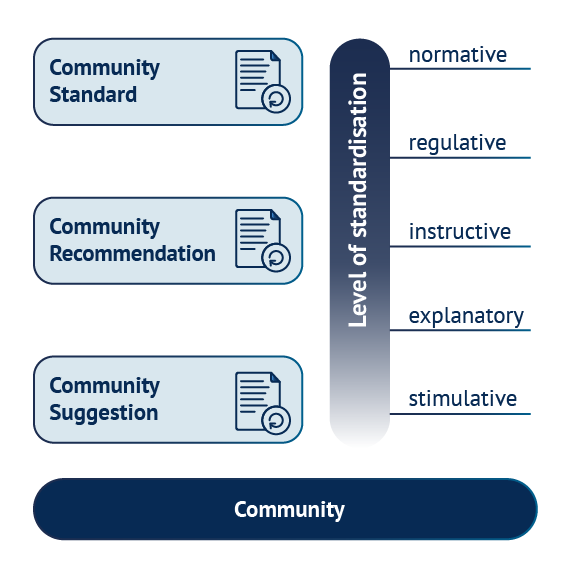Standards
Standards are at the centre of the requirements that the community has given NFDI4Objects.
Instead of approaching the term with a well-known comic strip, we are borrowing a quote from Russel Andrew and Lee Vinsel to provide NFDI4Objects with content for the term ‘standard’:
The basic irony of standards is the simple fact that there is no standard way to create a standard, nor is there even a standard definition of ‘standard’.
Community standards in NFDI4Objects
For the activities in the consortium, NFDI4Objects assumes a very broad understanding of standards. In an environment characterised by individual, project- or institution-specific practices, the consortium works with standardisation levels ranging from stimulative proposals to normative specifications.
Community standards in NFDI4Objects
For the activities in the consortium, NFDI4Objects assumes a very broad understanding of standards. In an environment characterised by individual, project- or institution-specific practices, the consortium works with standardisation levels ranging from stimulative proposals to normative specifications.

Development of open standards
The second principle postulated by Andrew and Vinsel is the question of how to turn a well-formulated proposal into a standard that is accepted by the community. For the implementation, NFDI4Objects orientates itself on established and successful role models that develop open standards:
- The IIIF (International Image Interoperability Framework) develops standards through two types of groups: Community Groups and Technical Specification Groups. Community groups focus on discussion and topic-specific collaboration, while Technical Specification Groups develop and refine the IIIF APIs. Both types of groups work openly, inclusively and transparently. Decision-making is based on open participation and respectful interaction, with a flexible governance structure that enables broad participation.
- The W3C (World Wide Web Consortium) develops standards in an open and transparent process that aims to build consensus. This process is organised by various groups, including working groups, interest groups and community groups, which work on the development and refinement of technical specifications. Decisions are made in a multi-phased process that includes public input and review by W3C members to ensure the quality and acceptance of the standards.
These two examples show that similar principles are applied in the development of open standards. In fact, detailed guidelines are available, for example from the Open Data Institute initiative or the Telecommunication Standardisation Sector of the International Telecommunication Union (ITU-T).
Prerequisites for standardisation
The following criteria, which are decisive for successful standardisation work, can be summarised from the exemplary models:
- A co-operative process enables the
- Voluntary and market-orientated development following a transparent, consensus-based process that is open to all interested parties in an appropriate manner.
- An appropriate balance ensures
- The process is not dominated by a single interest group.
- Proper procedures
- Include consideration and response to comments from interested parties.
- Quality and level of detail are
- sufficient to allow the development of a variety of competing implementations of interoperable products or services.
- Publicly available means
- accessible for implementation and use
- Ongoing support is a prerequisite for
- Maintenance and support over a long period of time
Summary
In short, standardisation work can succeed if it is designed as a cooperative process with an appropriate balance between the stakeholders, if it follows an orderly process, if the quality is ensured by a high level of detail and if the results are publicly and freely available and continuously maintained.
NFDI4Objects has developed the commons processes to create these conditions. In doing so, the sometimes complex processes of the role models were considerably streamlined. The aim is to establish these processes in the community in such a way that they can be placed in the hands of the professional organisations in whole or in part. back to top